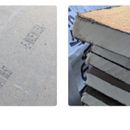What type of foam is this?
I’m trying to ID this foam. It’s a paper backed with little dimples, and would have been purchased in Northern California this year. One side is blank green, the other is blank green with a date stamp and the curious marking “E MADE IN USA“.
GBA Detail Library
A collection of one thousand construction details organized by climate and house part










Replies
Looks like fiber faced roofing polyiso to me. The very fine structure of the foam looks like polyiso. EPS looks like beads (since they make it by expanding polystyrene beads), and XPS is not usually faced, and is also typically colored by the manufacturer (blue, pink, etc.). Polyiso is a slightly yellow white color with a very fine structure to it, and it normally has either a foil, kraft paper, or fiberglass mat facing. Kraft paper and fiberglass mat are both normally referred to as "fiber" facers. If it tears like paper, then it's kraft paper.
I'm pretty sure fiber faced roofing polyiso is what you have here, and it's a good product.
Bill
It's slightly yellow and has a fine grain like polyiso.
Is there a reason for fiber faced in roofing, rather than foil faced which holds seam tape better, and has a higher LTTR?
The various facers are listed at
https://www.polyiso.org/page/Facers
Though without the why. My understanding is the foil is meant to retain the blowing gas as long as possible.
The fiber facer allows for some moisture migration through the material. It's the foil facer that makes polyiso a vapor barrier -- if you have a vapor permeable facer, polyiso is no longer a vapor barrier, and starts to act more like EPS in terms of vapor permeance.
Bill